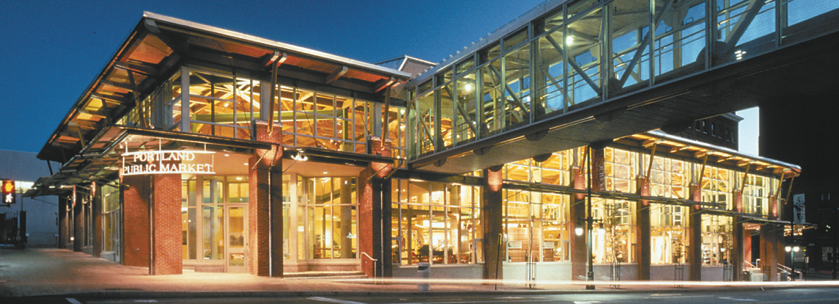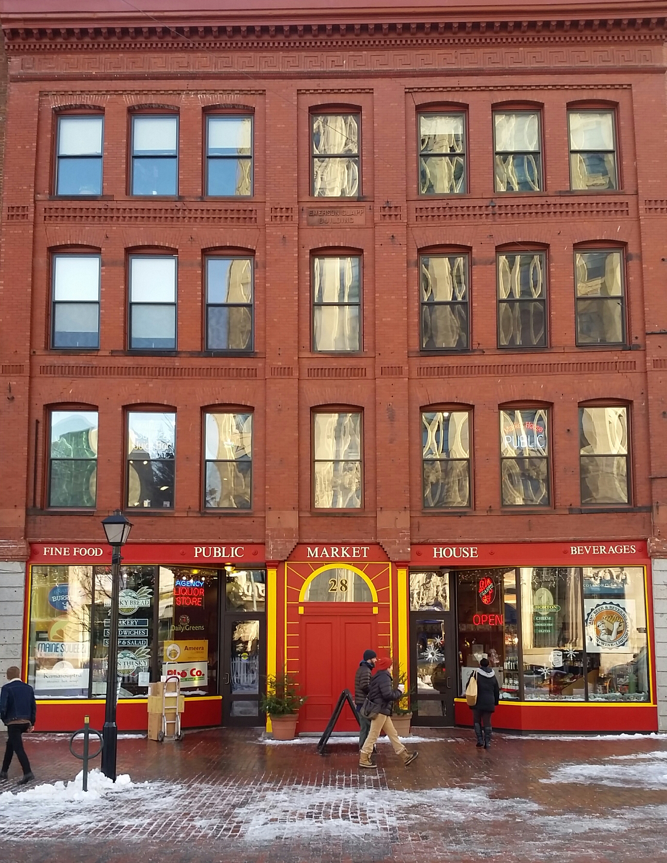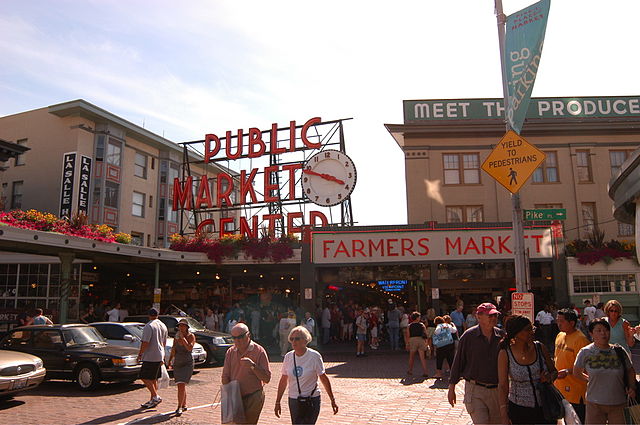|
|
Student Corner: One City, Two Public Markets: Case Studies of Success and Failure in Portland, MaineBy CED Program Interns & StudentsPublished February 9, 2017
 Portland, Maine, like many small urban communities across the country, faced economic decline and increasing vacancy in the 1970s and 1980s. To spur development and support downtown Portland Philanthropist Elizabeth Noyce and her October Foundation (later reimagined as the Libra Foundation) invested directly in real estate in Downtown Portland, bringing anchors like LL Bean and Olympia sports to new buildings along the main commercial street. The Libra Foundation became interested in building a new public market in Portland in the late 1990s. In 1998, the new Portland Public Market opened in a new, 37,000 SF, $9.9 million building financed primarily through the Libra Foundation, although the city contributed $250,000 in streetscape improvements and vendors contributed $1.1 in tenant improvements. By 2006, however the Libra Foundation announced its plans to sell the building. The markets failures have been attributed primarily to:
 The Portland Public Market House was formed in the wake of the Libra Foundation’s Portland Public Market by four of its former vendors. The vendors found a new home on Monument Square on Portland’s busy Congress Street, opening in 2006. The new building is not a traditional market space, occupying the first and second floors of its cramped building. The market however has been a success, both in meeting financial longevity and accomplishing public interests. The new market is a success due primarily due to its location and management. Its location on Monument Square is next to Portland’s farmers market during the summer months and amidst the many lunch patrons of downtown Portland, offering synergies that attract customers looking for a wide variety of foodstuffs. The original vendors are owners and managers of the market, allowing them to choose vendors that match their own experience and guide the market’s development in a way that was not possible in the market’s earlier iteration. The market now focuses on prepared meals made from local ingredients and supplements by offering value added products for home use. The public also benefits from the new market through community and economic development. In addition to providing a key meeting node for the neighborhood, the market vendors installed a community kitchen in the building’s basement which can be rented for a reasonable price by the public. The market’s success has further defined Portland as a food destination for locals and tourists. Four businesses got their start in the market and have since spun off to larger locations, while other vendors are businesses that have been able to survive store closings by moving into the market. The nimbleness of the market to respond to customer and vendor demands has made it an economic development asset in downtown Portland. Lessons Public Markets continue to have an important strategic role in communities around the country. The two public markets in Portland Maine represent two innovative models of public market revitalization and local food investment. Despite considerable equity support through a philanthropic foundation, the Portland Public Market case should be a lesson in the importance of matching products to markets and a reminder of the important role income property investors play in stabilizing downtown markets. The unique management structure of the new market and it’s experimental size offer communities without large traditional market space or single leader to organize existing businesses to better take advantage of complimentary markets and reduced operating costs. Moreover, these two cases reflect the importance in building trust and clear lines of communication between the market, it’s vendors, and the public to produce a quality public space that is an asset to the community and the local economy. Peter Gorman is a Master’s candidate in the UNC-Chapel Hill Department of City and Regional Planning specializing in Economic Development and a Community Revitalization Fellow with the Development Finance Initiative. |
Published February 9, 2017 By CED Program Interns & Students
 Public Markets are often used as a tool in downtown revitalization. They are attractive uses for vacant building with large footprints and bring high value and high-demand local food options to consumers, drive foot traffic, and catalyze new development. In the last 20 years, Portland, Maine, has seen two models of Public Markets try to bring the energy and options of Public Markets. The Portland Public Market set an innovative model of philanthropic foundation leadership, but failed to find success in its large-format, appearance-first space. In contrast, the Portland Public Market House is a successful model that brought vendor ownership and management and location choice to overcome building layout and financing challenges.
Public Markets are often used as a tool in downtown revitalization. They are attractive uses for vacant building with large footprints and bring high value and high-demand local food options to consumers, drive foot traffic, and catalyze new development. In the last 20 years, Portland, Maine, has seen two models of Public Markets try to bring the energy and options of Public Markets. The Portland Public Market set an innovative model of philanthropic foundation leadership, but failed to find success in its large-format, appearance-first space. In contrast, the Portland Public Market House is a successful model that brought vendor ownership and management and location choice to overcome building layout and financing challenges.

Portland, Maine, like many small urban communities across the country, faced economic decline and increasing vacancy in the 1970s and 1980s. To spur development and support downtown Portland Philanthropist Elizabeth Noyce and her October Foundation (later reimagined as the Libra Foundation) invested directly in real estate in Downtown Portland, bringing anchors like LL Bean and Olympia sports to new buildings along the main commercial street. The Libra Foundation became interested in building a new public market in Portland in the late 1990s. In 1998, the new Portland Public Market opened in a new, 37,000 SF, $9.9 million building financed primarily through the Libra Foundation, although the city contributed $250,000 in streetscape improvements and vendors contributed $1.1 in tenant improvements. By 2006, however the Libra Foundation announced its plans to sell the building. The markets failures have been attributed primarily to:
- Restricted control of the tenant mix: The Libra Foundation maintained tight control the tenants. Market management prioritized certain types of tenants to the point of putting subsidized, foundation owned, businesses in as much as one third of the market space.
- Emphasis on European Style market: The Portland Public Market was regulated by market management to cater to grocery shoppers. Its location right off of Portland’s Maine office district, however, drew lunch patrons looking for a meal. The market was unable to restructure its model to capture this market.
- Foundation lack of operating return expectations: The Libra Foundation did not expect the market to make money. Vendors paid $20 a square foot that cost the foundation $75. They did see their real estate holding in downtown Portland as investments, however. The foundation sold its downtown holdings in 2006 for $55 million, $20 million more than its original investment and had little interest in maintaining the market in its current use.

The Portland Public Market House was formed in the wake of the Libra Foundation’s Portland Public Market by four of its former vendors. The vendors found a new home on Monument Square on Portland’s busy Congress Street, opening in 2006. The new building is not a traditional market space, occupying the first and second floors of its cramped building. The market however has been a success, both in meeting financial longevity and accomplishing public interests.
The new market is a success due primarily due to its location and management. Its location on Monument Square is next to Portland’s farmers market during the summer months and amidst the many lunch patrons of downtown Portland, offering synergies that attract customers looking for a wide variety of foodstuffs. The original vendors are owners and managers of the market, allowing them to choose vendors that match their own experience and guide the market’s development in a way that was not possible in the market’s earlier iteration. The market now focuses on prepared meals made from local ingredients and supplements by offering value added products for home use.
The public also benefits from the new market through community and economic development. In addition to providing a key meeting node for the neighborhood, the market vendors installed a community kitchen in the building’s basement which can be rented for a reasonable price by the public. The market’s success has further defined Portland as a food destination for locals and tourists. Four businesses got their start in the market and have since spun off to larger locations, while other vendors are businesses that have been able to survive store closings by moving into the market. The nimbleness of the market to respond to customer and vendor demands has made it an economic development asset in downtown Portland.
Lessons
Public Markets continue to have an important strategic role in communities around the country. The two public markets in Portland Maine represent two innovative models of public market revitalization and local food investment. Despite considerable equity support through a philanthropic foundation, the Portland Public Market case should be a lesson in the importance of matching products to markets and a reminder of the important role income property investors play in stabilizing downtown markets. The unique management structure of the new market and it’s experimental size offer communities without large traditional market space or single leader to organize existing businesses to better take advantage of complimentary markets and reduced operating costs. Moreover, these two cases reflect the importance in building trust and clear lines of communication between the market, it’s vendors, and the public to produce a quality public space that is an asset to the community and the local economy.
Peter Gorman is a Master’s candidate in the UNC-Chapel Hill Department of City and Regional Planning specializing in Economic Development and a Community Revitalization Fellow with the Development Finance Initiative.
Author(s)
Tagged Under
This blog post is published and posted online by the School of Government to address issues of interest to government officials. This blog post is for educational and informational Copyright ©️ 2009 to present School of Government at the University of North Carolina. All rights reserved. use and may be used for those purposes without permission by providing acknowledgment of its source. Use of this blog post for commercial purposes is prohibited. To browse a complete catalog of School of Government publications, please visit the School’s website at www.sog.unc.edu or contact the Bookstore, School of Government, CB# 3330 Knapp-Sanders Building, UNC Chapel Hill, Chapel Hill, NC 27599-3330; e-mail sales@sog.unc.edu; telephone 919.966.4119; or fax 919.962.2707.

